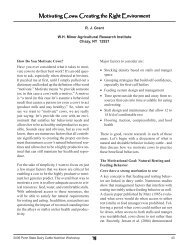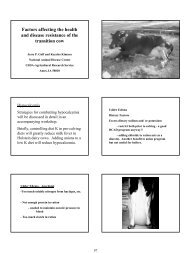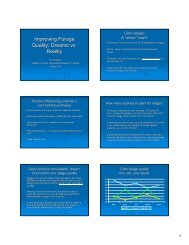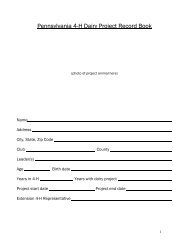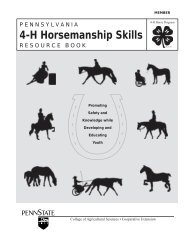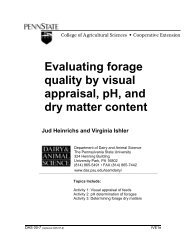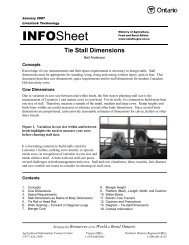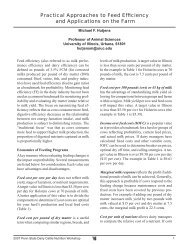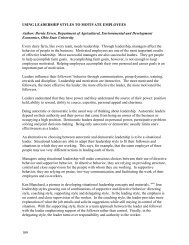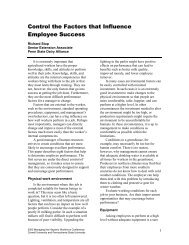DETERMINING THE MINERAL REQUIREMENT OF DAIRY CATTLE
DETERMINING THE MINERAL REQUIREMENT OF DAIRY CATTLE
DETERMINING THE MINERAL REQUIREMENT OF DAIRY CATTLE
You also want an ePaper? Increase the reach of your titles
YUMPU automatically turns print PDFs into web optimized ePapers that Google loves.
Since metabolic alkalosis is an important factor in the etiology of milk fever it is<br />
important to prevent metabolic alkalosis. Dry cow diets that are high in K and / or Na<br />
alkalinize the cow's blood and increase the susceptibility to milk fever. Adding Ca to<br />
practical prepartal diets does not increase the incidence of milk fever. The landmark<br />
studies of Ender et al. 1967 demonstrated that addition of anions to the prepartal diet could<br />
prevent milk fever. Ammonium, Ca and Mg salts of Cl and sulfate have been successfully<br />
used as acidifying anion sources. Cl salts are more acidogenic than sulfate salts.<br />
Hydrochloric acid has also been successfully utilized as a source of anions for prevention<br />
of milk fever and is the most potent of the anion sources available<br />
A second common cause of hypocalcemia and milk fever in the periparturient cow is<br />
hypomagnesemia. Low blood Mg can reduce PTH secretion from the parathyroid glands<br />
causing temporary hypoparathyroidism and can alter the responsiveness of tissues to PTH<br />
by inducing conformational changes in the PTH receptor, again causing temporary<br />
pseudohypoparathyroidism.<br />
Phosphorus (Phos)<br />
Phos is primarily absorbed in the small intestine via an active transport process that is<br />
responsive to 1,25-dihydroxyvitamin D. Intestinal Phos absorption efficiency can be<br />
upregulated during periods of Phos deficiency as renal production of 1,25-dihydroxyvitamin<br />
D is directly stimulated by very low plasma Phos. Plasma Phos concentrations are well<br />
correlated with dietary Phos absorption. Phos absorbed in excess of needs is excreted in<br />
urine and saliva.<br />
Parathyroid hormone, secreted during periods of Ca stress, increases renal and<br />
salivary excretion of Phos which can be detrimental to maintenance of normal blood Phos<br />
concentrations. This is one reason that hypocalcemic animals tend to become<br />
hypophosphatemic. Parathyroid hormone could conceivably increase blood Phos<br />
concentration since it stimulates bone mineral resorption. However, parathyroid hormone<br />
is secreted in response to hypocalcemia, not hypophosphatemia. This means that Phos<br />
homeostasis and Ca homeostasis are sometimes at odds.<br />
Salivary secretions remove between 30 and 90 g Phos from the extracellular Phos<br />
pool each day depending, with higher amounts secreted when dietay Phos is high.<br />
Salivary Phos secretions supply rumen microbes with a readily available source of Phos<br />
which appears necessary for cellulose digestion. Most, but not all, of the salivary Phos<br />
secreted is recovered by intestinal absorption.<br />
Rumen microbes are able to digest phytic acid so that much of the phytate-bound<br />
Phos, the major form of Phos in plants, is available for absorption in ruminants.<br />
Factorial Phos Requirement<br />
Maintenance<br />
1989 NRC- 1.43 g / 100 kg Bwt = 8.6 g for 600 kg cow<br />
Rest of the world - uses 1.2 g P / g DM intake<br />
- for a cow eating 20 kg DM / day = 24 g / day.<br />
Pregnancy -increases exponentially<br />
-from 1.5 g / day at day 190 to 6 g / day just before calving.<br />
Growth<br />
Young animals require more Phos / kg BWt gained than older animals as skeleton forms<br />
Varies from 9 when young to 6 when nearly an adult g Phos /kg Live Wt gained.<br />
Lactation = 0.9 g Phos / kg 4% FCM milk<br />
38




